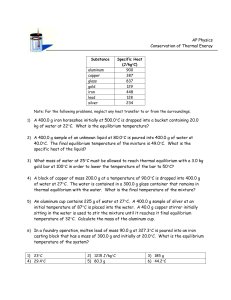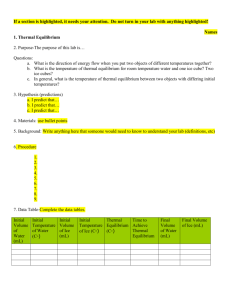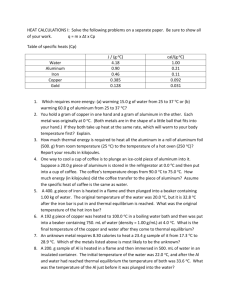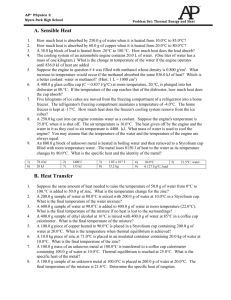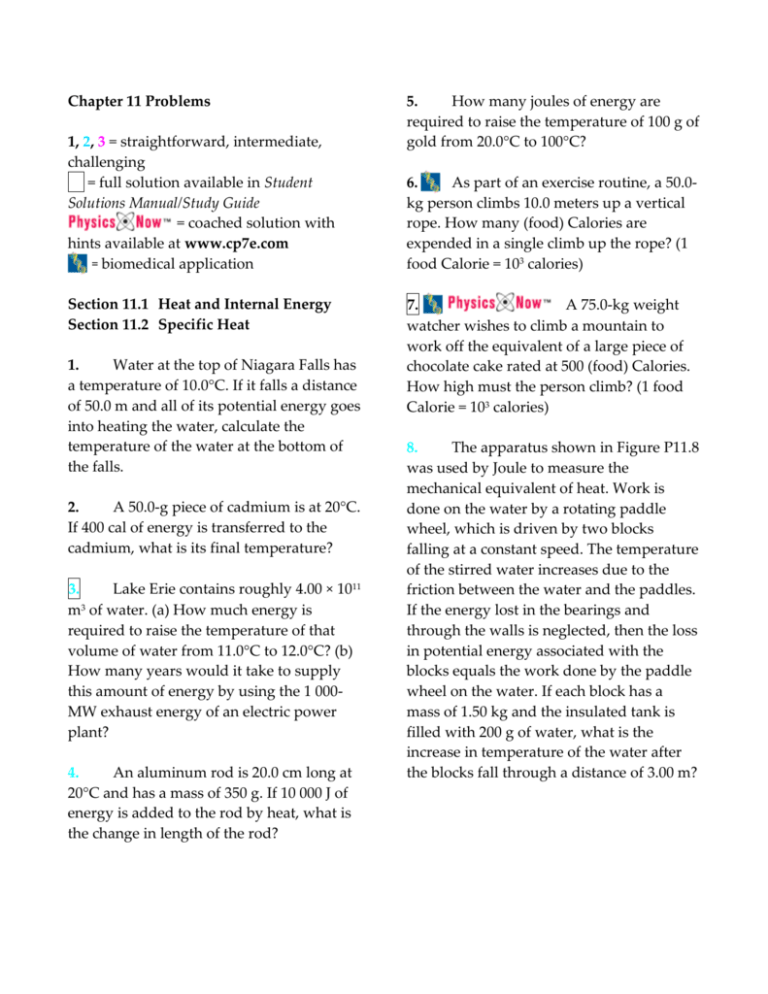
Chapter 11 Problems
1, 2, 3 = straightforward, intermediate,
challenging
= full solution available in Student
Solutions Manual/Study Guide
= coached solution with
hints available at www.cp7e.com
= biomedical application
Section 11.1 Heat and Internal Energy
Section 11.2 Specific Heat
1.
Water at the top of Niagara Falls has
a temperature of 10.0°C. If it falls a distance
of 50.0 m and all of its potential energy goes
into heating the water, calculate the
temperature of the water at the bottom of
the falls.
2.
A 50.0-g piece of cadmium is at 20°C.
If 400 cal of energy is transferred to the
cadmium, what is its final temperature?
3.
Lake Erie contains roughly 4.00 × 1011
m3 of water. (a) How much energy is
required to raise the temperature of that
volume of water from 11.0°C to 12.0°C? (b)
How many years would it take to supply
this amount of energy by using the 1 000MW exhaust energy of an electric power
plant?
4.
An aluminum rod is 20.0 cm long at
20°C and has a mass of 350 g. If 10 000 J of
energy is added to the rod by heat, what is
the change in length of the rod?
5.
How many joules of energy are
required to raise the temperature of 100 g of
gold from 20.0°C to 100°C?
6.
As part of an exercise routine, a 50.0kg person climbs 10.0 meters up a vertical
rope. How many (food) Calories are
expended in a single climb up the rope? (1
food Calorie = 103 calories)
7.
A 75.0-kg weight
watcher wishes to climb a mountain to
work off the equivalent of a large piece of
chocolate cake rated at 500 (food) Calories.
How high must the person climb? (1 food
Calorie = 103 calories)
8.
The apparatus shown in Figure P11.8
was used by Joule to measure the
mechanical equivalent of heat. Work is
done on the water by a rotating paddle
wheel, which is driven by two blocks
falling at a constant speed. The temperature
of the stirred water increases due to the
friction between the water and the paddles.
If the energy lost in the bearings and
through the walls is neglected, then the loss
in potential energy associated with the
blocks equals the work done by the paddle
wheel on the water. If each block has a
mass of 1.50 kg and the insulated tank is
filled with 200 g of water, what is the
increase in temperature of the water after
the blocks fall through a distance of 3.00 m?
11.
A 200-g aluminum cup contains 800
g of water in thermal equilibrium with the
cup at 80°C. The combination of cup and
water is cooled uniformly so that the
temperature decreases by 1.5°C per minute.
At what rate is energy being removed?
Express your answer in watts.
Section 11.3 Calorimetry
12.
Lead pellets, each of mass 1.00 g, are
heated to 200°C. How many pellets must be
added to 500 g of water that is initially at
20.0°C to make the equilibrium temperature
25.0°C? Neglect any energy transfer to or
from the container.
Figure P11.8 The falling weights rotate the
paddles, causing the temperature of the
water to increase.
9.
A 5.00-g lead bullet traveling at 300
m/s is stopped by a large tree. If half the
kinetic energy of the bullet is transformed
into internal energy and remains with the
bullet while the other half is transmitted to
the tree, what is the increase in temperature
of the bullet?
10.
A 1.5-kg copper block is given an
initial speed of 3.0 m/s on a rough
horizontal surface. Because of friction, the
block finally comes to rest. (a) If the block
absorbs 85% of its initial kinetic energy as
internal energy, calculate its increase in
temperature. (b) What happens to the
remaining energy?
13.
What mass of water at 25.0°C must
be allowed to come to thermal equilibrium
with a 3.00-kg gold bar at 100°C in order to
lower the temperature of the bar to 50.0°C?
14.
In a showdown on the streets of
Laredo, the good guy drops a 5.0-g silver
bullet at a temperature of 20°C into a 100cm3 cup of water at 90°C. Simultaneously,
the bad guy drops a 5.0-g copper bullet at
the same initial temperature into an
identical cup of water. Which one ends the
showdown with the coolest cup of water in
the west? Neglect any energy transfer into
or away from the container.
15.
An aluminum cup
contains 225 g of water and a 40-g copper
stirrer, all at 27°C. A 400-g sample of silver
at an initial temperature of 87°C is placed in
the water. The stirrer is used to stir the
mixture until it reaches its final equilibrium
temperature of 32°C. Calculate the mass of
the aluminum cup.
temperature of 25°C, precisely where it
started. What is the mass of the aluminum
chunk?
16.
It is desired to cool iron parts from
500°F to 100°F by dropping them into water
that is initially at 75°F. Assuming that all
the heat from the iron is transferred to the
water and that none of the water
evaporates, how many kilograms of water
are needed per kilogram of iron?
Section 11.4 Latent Heat and Phase
Change
17.
A 100-g aluminum calorimeter
contains 250 g of water. The two substances
are in thermal equilibrium at 10°C. Two
metallic blocks are placed in the water. One
is a 50-g piece of copper at 80°C. The other
sample has a mass of 70 g and is originally
at a temperature of 100°C. The entire
system stabilizes at a final temperature of
20°C. Determine the specific heat of the
unknown second sample.
18.
When a driver brakes an automobile,
the friction between the brake drums and
the brake shoes converts the car’s kinetic
energy to thermal energy. If a 1 500-kg
automobile traveling at 30 m/s comes to a
halt, how much does the temperature rise
in each of the four 8.0-kg iron brake drums?
(The specific heat of iron is 448 J/kg ∙ °C.)
19.
A student drops two metallic objects
into a 120-g steel container holding 150 g of
water at 25°C. One object is a 200-g cube of
copper that is initially at 85°C, and the
other is a chunk of aluminum that is
initially at 5.0°C. To the surprise of the
student, the water reaches a final
20.
A 50-g ice cube at 0°C is heated until
45 g has become water at 100°C and 5.0 g
has become steam at 100°C. How much
energy was added to accomplish the
transformation?
21.
A 100-g cube of ice at 0°C is dropped
into 1.0 kg of water that was originally at
80°C. What is the final temperature of the
water after the ice has melted?
22.
How much energy is required to
change a 40-g ice cube from ice at –10°C to
steam at 110°C?
23.
What mass of steam that is initially
at 120°C is needed to warm 350 g of water
and its 300-g aluminum container from
20°C to 50°C?
24.
A resting adult of average size
converts chemical energy in food into
internal energy at the rate of 120 W, called
her basal metabolic rate. To stay at a constant
temperature, energy must be transferred
out of the body at the same rate. Several
processes exhaust energy from your body.
Usually the most important is thermal
conduction into the air in contact with your
exposed skin. If you are not wearing a hat,
a convection current of warm air rises
vertically from your head like a plume from
a smokestack. Your body also loses energy
by electromagnetic radiation, by your
exhaling warm air, and by the evaporation
of perspiration. Now consider still another
pathway for energy loss: moisture in
exhaled breath. Suppose you breathe out
22.0 breaths per minute, each with a
volume of 0.600 L. Suppose also that you
inhale dry air and exhale air at 37°C
containing water vapor with a vapor
pressure of 3.20 kPa. The vapor comes from
the evaporation of liquid water in your
body. Model the water vapor as an ideal
gas. Assume its latent heat of evaporation
at 37°C is the same as its heat of
vaporization at 100°C. Calculate the rate at
which you lose energy by exhaling humid
air.
25.
A 75-kg cross-country skier glides
over snow as in Figure P11.25. The
coefficient of friction between skis and
snow is 0.20. Assume all the snow beneath
his skis is at 0°C and that all the internal
energy generated by friction is added to
snow, which sticks to his skis until it melts.
How far would he have to ski to melt 1.0 kg
of snow?
Nathan Bilow/Leo de Wys, Inc.
Figure P11.25 A cross-country skier.
26.
When you jog, most of the food
energy you burn above your basal
metabolic rate (BMR) ends up as internal
energy that would raise your body
temperature if it were not eliminated. The
evaporation of perspiration is the primary
mechanism for eliminating this energy.
Determine the amount of water you lose to
evaporation when running for 30 minutes
at a rate that uses 400 kcal/h above your
BMR. (That amount is often considered to
be the “maximum fat-burning” energy
output.) The metabolism of 1 gram of fat
generates approximately 9.0 kcal of energy
and produces approximately 1 gram of
water. (The hydrogen atoms in the fat
molecule are transferred to oxygen to form
water.) What fraction of your need for
water will be provided by fat metabolism?
(The latent heat of vaporization of water at
room temperature is 2.5 × 106 J/kg).
27.
A 40-g block of ice is cooled to –78°C
and is then added to 560 g of water in an
80-g copper calorimeter at a temperature of
25°C. Determine the final temperature of
the system consisting of the ice, water, and
calorimeter. (If not all the ice melts,
determine how much ice is left.) Remember
that the ice must first warm to 0°C, melt,
and then continue warming as water. The
specific heat of ice is 0.500 cal/g ∙ °C = 2090
J/kg ∙ °C.
28.
A 60.0-kg runner expends 300 W of
power while running a marathon.
Assuming that 10.0% of the energy is
delivered to the muscle tissue and that the
excess energy is removed from the body
primarily by sweating, determine the
volume of bodily fluid (assume it is water)
lost per hour. (At 37.0°C, the latent heat of
vaporization of water is 2.41 × 106 J/kg.)
31.
Steam at 100°C is added to ice at 0°C.
(a) Find the amount of ice melted and the
final temperature when the mass of steam
is 10 g and the mass of ice is 50 g. (b) Repeat
with steam of mass 1.0 g and ice of mass 50
g.
Section 11.5 Energy Transfer
© Jim Bourg/Reuters/Corbis
Figure P11.28 Timothy Cherigat of Kenya,
winner of the Boston Marathon in 2004.
29.
A high-end gas stove usually has at
least one burner rated at 14 000 Btu/h. If
you place a 0.25-kg aluminum pot
containing 2.0 liters of water at 20°C on this
burner, how long will it take to bring the
water to a boil, assuming all of the heat
from the burner goes into the pot? How
long will it take to boil all of the water out
of the pot?
30.
A beaker of water sits in the sun
until it reaches an equilibrium temperature
of 30°C. The beaker is made of 100 g of
aluminum and contains 180 g of water. In
an attempt to cool this system, 100 g of ice
at 0°C is added to the water. (a) Determine
the final temperature of the system. If Tf =
0°C, determine how much ice remains. (b)
Repeat your calculations for 50 g of ice.
32.
The average thermal conductivity of
the walls (including windows) and roof of a
house in Figure P11.32 is 4.8 × 10–4 kW/m ∙
°C, and their average thickness is 21.0 cm.
The house is heated with natural gas, with a
heat of combustion (energy released per
cubic meter of gas burned) of 9300 kcal/m3.
How many cubic meters of gas must be
burned each day to maintain an inside
temperature of 25.0°C if the outside
temperature is 0.0°C? Disregard radiation
and energy loss by heat through the
ground.
Figure P11.32
33.
(a) Find the rate of energy flow
through a copper block of cross-sectional
area 15 cm2 and length 8.0 cm when a
temperature difference of 30°C is
established across the block. Repeat the
calculation, assuming that the material is
(b) a block of stagnant air with the given
dimensions; (c) a block of wood with the
given dimensions.
34.
A window has a glass surface area of
1.6 × 103 cm2 and a thickness of 3.0 mm. (a)
Find the rate of energy transfer by
conduction through the window when the
temperature of the inside surface of the
glass is 70°F and the outside temperature is
90°F. (b) Repeat for the same inside
temperature and an outside temperature of
0°F.
35.
A steam pipe is
covered with 1.50-cm-thick insulating
material of thermal conductivity 0.200
cal/cm ∙ °C ∙ s. How much energy is lost
every second when the steam is at 200°C
and the surrounding air is at 20.0°C? The
pipe has a circumference of 800 cm and a
length of 50.0 m. Neglect losses through the
ends of the pipe.
36.
A box with a total surface area of
2
1.20 m and a wall thickness of 4.00 cm is
made of an insulating material. A 10.0-W
electric heater inside the box maintains the
inside temperature at 15.0°C above the
outside temperature. Find the thermal
conductivity k of the insulating material.
37.
Determine the R value for a wall
constructed as follows: The outside of the
house consists of lapped wood shingles
placed over 0.50-in.-thick sheathing, over
3.0 in. of cellulose fiber, over 0.50 in. of
drywall.
38.
A thermopane window consists of
two glass panes, each 0.50 cm thick, with a
1.0-cm-thick sealed layer of air in between.
If the inside surface temperature is 23°C
and the outside surface temperature is
0.0°C, determine the rate of energy transfer
through 1.0 m2 of the window. Compare
your answer with the rate of energy
transfer through 1.0 m2 of a single 1.0-cmthick pane of glass.
39.
A copper rod and an aluminum rod
of equal diameter are joined end to end in
good thermal contact. The temperature of
the free end of the copper rod is held
constant at 100°C, and that of the far end of
the aluminum rod is held at 0°C. If the
copper rod is 0.15 m long, what must be the
length of the aluminum rod so that the
temperature at the junction is 50°C?
40.
A Styrofoam box has a surface area
of 0.80 m2 and a wall thickness of 2.0 cm.
The temperature of the inner surface is
5.0°C, and the outside temperature is 25°C.
If it takes 8.0 h for 5.0 kg of ice to melt in the
container, determine the thermal
conductivity of the Styrofoam.
41.
A sphere that is a perfect blackbody
radiator has a radius of 0.060 m and is at
200°C in a room where the temperature is
22°C. Calculate the net rate at which the
sphere radiates energy.
42.
The surface temperature of the Sun
is about 5 800 K. Taking the radius of the
Sun to be 6.96 × 108 m, calculate the total
energy radiated by the Sun each second.
(Assume e = 0.965.)
43.
A large, hot pizza 70 cm in diameter
and 2.0 cm thick, at a temperature of 100°C,
floats in outer space. Assume its emissivity
is 0.8. What is the order of magnitude of its
rate of energy loss?
44.
Calculate the temperature at which a
tungsten filament that has an emissivity of
0.90 and a surface area of 2.5 × 10–5 m2 will
radiate energy at the rate of 25 W in a room
where the temperature is 22°C.
45.
Measurements on two stars indicate
that Star X has a surface temperature of 5
727°C and Star Y has a surface temperature
of 11 727°C. If both stars have the same
radius, what is the ratio of the luminosity
(total power output) of Star Y to the
luminosity of Star X? Both stars can be
considered to have an emissivity of 1.0.
46.
At high noon, the Sun delivers 1.00
kW to each square meter of a blacktop road.
If the hot asphalt loses energy only by
radiation, what is its equilibrium
temperature?
Additional Problems
47.
The bottom of a copper kettle has a
10-cm radius and is 2.0 mm thick. The
temperature of the outside surface is 102°C,
and the water inside the kettle is boiling at
1 atm of pressure. Find the rate at which
energy is being transferred through the
bottom of the kettle.
48.
A family comes home from a long
vacation with laundry to do and showers to
take. The water heater has been turned off
during the vacation. If the heater has a
capacity of 50.0 gallons and a 4 800-W
heating element, how much time is
required to raise the temperature of the
water from 20.0°C to 60.0°C? Assume that
the heater is well insulated and no water is
withdrawn from the tank during that time.
49.
Solar energy can be the primary
source of winter space heating for a typical
house (with floor area 130 m2 = 1 400 ft2) in
the north central United States. If the house
has very good insulation, you may model it
as losing energy by heat steadily at the rate
of 1 000 W during the winter, when the
average exterior temperature is –5°C. The
passive solar-energy collector can consist
simply of large windows facing south.
Sunlight shining in during the daytime is
absorbed by the floor, interior walls, and
objects in the house, raising their
temperature to 30°C. As the sun goes down,
insulating draperies or shutters are closed
over the windows. During the period
between 4 PM and 8 AM, the temperature
of the house will drop, and a sufficiently
large “thermal mass” is required to keep it
from dropping too far. The thermal mass
can be a large quantity of stone (with
specific heat 800 J/kg ∙ °C) in the floor and
the interior walls exposed to sunlight. What
mass of stone is required if the temperature
is not to drop below 18°C overnight?
50.
A water heater is operated by solar
power. If the solar collector has an area of
6.00 m2, and the intensity delivered by
sunlight is 550 W/m2, how long does it take
to increase the temperature of 1.00 m3 of
water from 20.0°C to 60.0°C?
51.
A 40-g ice cube floats in 200 g of
water in a 100-g copper cup; all are at a
temperature of 0°C. A piece of lead at 98°C
is dropped into the cup, and the final
equilibrium temperature is 12°C. What is
the mass of the lead?
52.
The evaporation of perspiration is
the primary mechanism for cooling the
human body. Estimate the amount of water
you will lose when you bake in the sun on
the beach for an hour. Use a value of 1 000
W/m2 for the intensity of sunlight, and note
that the energy required to evaporate a
liquid at a particular temperature is
approximately equal to the sum of the
energy required to raise its temperature to
the boiling point and the latent heat of
vaporization (determined at the boiling
point).
53.
A 200-g block of copper at a
temperature of 90°C is dropped into 400 g
of water at 27°C. The water is contained in
a 300-g glass container. What is the final
temperature of the mixture?
54.
A class of 10 students taking an
exam has a power output per student of
about 200 W. Assume that the initial
temperature of the room is 20°C and that its
dimensions are 6.0 m by 15.0 m by 3.0 m.
What is the temperature of the room at the
end of 1.0 h if all the energy remains in the
air in the room and none is added by an
outside source? The specific heat of air is
837 J/kg ∙ °C, and its density is about 1.3 ×
10–3 g/cm3.
55.
The human body must maintain its
core temperature inside a rather narrow
range around 37°C. Metabolic processes
(notably, muscular exertion) convert
chemical energy into internal energy deep
in the interior. From the interior, energy
must flow out to the skin or lungs, to be lost
by heat to the environment. During
moderate exercise, an 80-kg man can
metabolize food energy at the rate of 300
kcal/h, do 60 kcal/h of mechanical work,
and put out the remaining 240 kcal/h of
energy by heat. Most of the energy is
carried from the interior of the body out to
the skin by “forced convection” (as a
plumber would say): Blood is warmed in
the interior and then cooled at the skin,
which is a few degrees cooler than the body
core. Without blood flow, living tissue is a
good thermal insulator, with a thermal
conductivity about 0.210 W/m ∙ °C. Show
that blood flow is essential to keeping the
body cool by calculating the rate of energy
conduction, in kcal/h, through the tissue
layer under the skin. Assume that its area is
1.40 m2, its thickness is 2.50 cm, and it is
maintained at 37.0°C on one side and at
34.0°C on the other side.
56.
An aluminum rod and an iron rod
are joined end to end in good thermal
contact. The two rods have equal lengths
and radii. The free end of the aluminum
rod is maintained at a temperature of
100°C, and the free end of the iron rod is
maintained at 0°C. (a) Determine the
temperature of the interface between the
two rods. (b) If each rod is 15 cm long and
each has a cross-sectional area of 5.0 cm2,
what quantity of energy is conducted
across the combination in 30 min?
57.
Water is being boiled in an open
kettle that has a 0.500-cm-thick circular
aluminum bottom with a radius of 12.0 cm.
If the water boils away at a rate of 0.500
kg/min, what is the temperature of the
lower surface of the bottom of the kettle?
Assume that the top surface of the bottom
of the kettle is at 100°C.
58.
A 3.00-g copper penny at 25.0°C
drops 50.0 m to the ground. (a) If 60.0% of
the initial potential energy associated with
the penny goes into increasing its internal
energy, determine the final temperature of
the penny. (b) Does the result depend on
the mass of the coin? Explain.
59.
A bar of gold (Au) is in thermal
contact with a bar of silver (Ag) of the same
length and area (Fig. P11.59). One end of
the compound bar is maintained at 80.0°C,
while the opposite end is at 30.0°C. Find the
temperature at the junction when the
energy flow reaches a steady state.
Figure P11.59
60.
An iron plate is held against an iron
wheel so that a sliding frictional force of 50
N acts between the two pieces of metal. The
relative speed at which the two surfaces
slide over each other is 40 m/s. (a) Calculate
the rate at which mechanical energy is
converted to internal energy. (b) The plate
and the wheel have masses of 5.0 kg each,
and each receives 50% of the internal
energy. If the system is run as described for
10 s, and each object is then allowed to
reach a uniform internal temperature, what
is the resultant temperature increase?
61.
An automobile has a mass of 1 500
kg, and its aluminum brakes have an
overall mass of 6.0 kg. (a) Assuming that all
of the internal energy transformed by
friction when the car stops is deposited in
the brakes, and neglecting energy transfer,
how many times could the car be braked to
rest starting from 25 m/s (56 mi/h) before
the brakes would begin to melt? (Assume
an initial temperature of 20°C.) (b) Identify
some effects that are neglected in part (a),
but are likely to be important in a more
realistic assessment of the temperature
increase of the brakes.
62.
A 1.0-m-long aluminum rod of crosssectional area 2.0 cm2 is inserted vertically
into a thermally insulated vessel containing
liquid helium at 4.2 K. The rod is initially at
300 K. If half of the rod is inserted into the
helium, how many liters of helium boil off
in the very short time while the inserted
half cools to 4.2 K? The density of liquid
helium at 4.2 K is 122 kg/m3.
63.
A flow calorimeter is
an apparatus used to measure the specific
heat of a liquid. The technique is to
measure the temperature difference
between the input and output points of a
flowing stream of the liquid while adding
energy at a known rate. (a) Start with the
equations Q = mc(ΔT) and m = ρV, and
show that the rate at which energy is added
to the liquid is given by the expression
ΔQ/Δt = ρc(ΔT )(ΔV/Δt). (b) In a particular
experiment, a liquid of density 0.72 g/cm3
flows through the calorimeter at the rate of
3.5 cm3/s. At steady state, a temperature
difference of 5.8°C is established between
the input and output points when energy is
supplied at the rate of 40 J/s. What is the
specific heat of the liquid?
64.
Three liquids are at temperatures of
10°C, 20°C, and 30°C, respectively. Equal
masses of the first two liquids are mixed,
and the equilibrium temperature is 17°C.
Equal masses of the second and third are
then mixed, and the equilibrium
temperature is 28°C. Find the equilibrium
temperature when equal masses of the first
and third are mixed.
65.
At time t = 0, a vessel contains a
mixture of 10 kg of water and an unknown
mass of ice in equilibrium at 0°C. The
temperature of the mixture is measured
over a period of an hour, with the following
results: During the first 50 min, the mixture
remains at 0°C; from 50 min to 60 min, the
temperature increases steadily from 0°C to
2°C. Neglecting the heat capacity of the
vessel, determine the mass of ice that was
initially placed in it. Assume a constant
power input to the container.
66.
A wood stove is used to heat a single
room. The stove is cylindrical in shape,
with a diameter of 40.0 cm and a length of
50.0 cm and operates at a temperature of
400°F. (a) If the temperature of the room is
70.0°F determine the amount of radiant
energy delivered to the room by the stove
each second if the emissivity is 0.920. (b) If
the room is a square with walls that are 8.00
ft high and 25.0 ft wide, determine the R
value needed in the walls and ceiling to
maintain the inside temperature at 70.0°F if
the outside temperature is 32.0°F. Note that
we are ignoring any heat conveyed by the
stove via convection and any energy lost
through the walls (and windows!) via
convection or radiation.
67.
A “solar cooker” consists of a curved
reflecting mirror that focuses sunlight onto
the object to be heated (Fig. P11.67). The
solar power per unit area reaching the
Earth at the location of a 0.50-m-diameter
solar cooker is 600 W/m2. Assuming that
50% of the incident energy is converted to
thermal energy, how long would it take to
boil away 1.0 L of water initially at 20°C?
(Neglect the specific heat of the container.)
Figure P11.67
68.
For bacteriological testing of water
supplies and in medical clinics, samples
must routinely be incubated for 24 h at
37°C. A standard constant temperature bath
with electric heating and thermostatic
control is not suitable in developing nations
without continuously operating electric
power lines. Peace Corps volunteer and
MIT engineer Amy Smith invented a low
cost, low maintenance incubator to fill the
need. The device consists of a foam-
© Copyright 2004 Thomson. All rights reserved.
insulated box containing several packets of
a waxy material that melts at 37.0°C,
interspersed among tubes, dishes, or bottles
containing the test samples and growth
medium (food for bacteria). Outside the
box, the waxy material is first melted by a
stove or solar energy collector. Then it is
put into the box to keep the test samples
warm as it solidifies. The heat of fusion of
the phase-change material is 205 kJ/kg.
Model the insulation as a panel with
surface area 0.490 m2, thickness 9.50 cm,
and conductivity 0.012 0 W/m°C. Assume
the exterior temperature is 23.0°C for 12.0 h
and 16.0°C for 12.0 h. (a) What mass of the
waxy material is required to conduct the
bacteriological test? (b) Explain why your
calculation can be done without knowing
the mass of the test samples or of the
insulation.
69.
What mass of steam initially at 130°C
is needed to warm 200 g of water in a 100-g
glass container from 20.0°C to 50.0°C?

